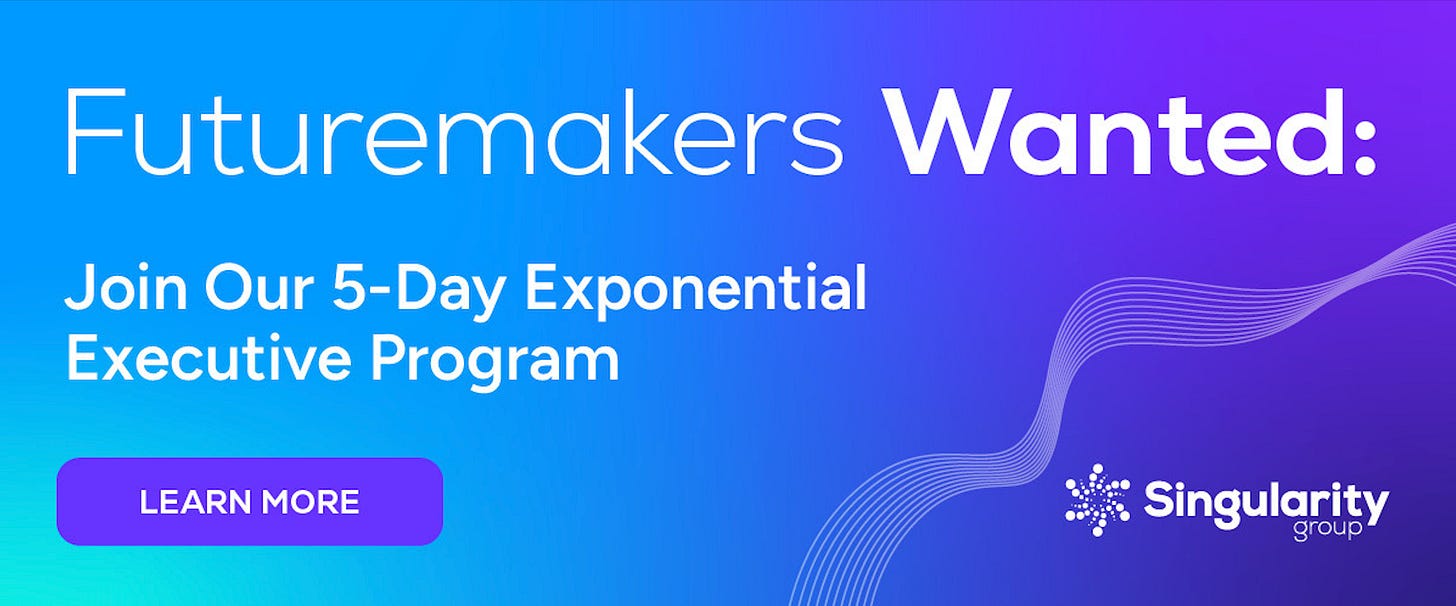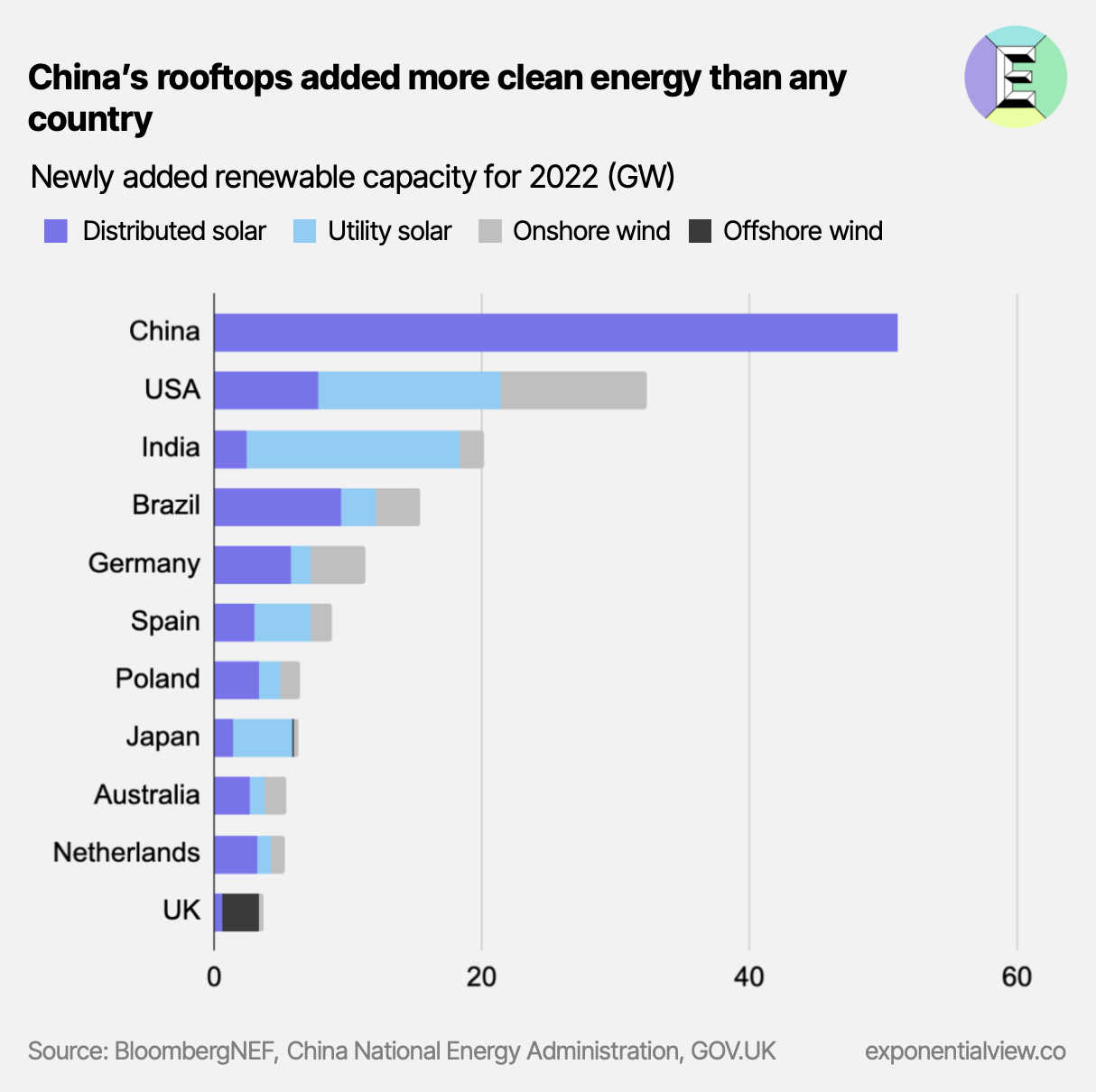
Hi, I’m Azeem Azhar. I advise governments, some of the world’s largest firms, and investors how to make sense of our exponential future. Every Sunday, I share my view on developments that I think you should know about.
In today’s edition:
AI risks and how to deal with radical uncertainty,
Modularity and productisation are leading to a boom in Chinese solar power,
LLMs are being brought out of their chatbot cradle.
⏱️ Read time: 9 minutes
Today’s edition is supported by our knowledge partner, Singularity Group.
As Exponential View readers know well, the Exponential Age is here. Singularity’s Executive Program is designed to keep you ahead of the curve. Hosted in Silicon Valley, this 5-day in-person program will immerse you in the fundamentals of exponential mindset — and help you identify the abundant opportunities inherent in exponential technology.
Sunday chart: Little pieces everywhere
Last year, China added more than 51 gigawatts of small-scale (“distributed”) solar power. This is more than the total clean energy additions (of small-scale and utility solar and wind) from the US, Germany, and the UK combined. On top of that, China also added another 100 gigawatts of utility solar and wind capacity.
Two years ago, I argued that the boom in solar PV in South Australia was a sign of things to come:
Australian citizens [launched] their own renewable energy revolution. Thanks to the sheer number of individuals who have installed rooftop solar panels on their homes.
The widespread adoption of rooftop solar can be attributed to its unique and highly advantageous characteristics. For one, it is modular, miniaturized, and easily incorporated into existing infrastructure. This results in an expanded market and a rapid acceleration in deployment rates. The inherent modularity of such technologies, reminiscent of Lego blocks, fuels exponential growth. With small, scalable units, production volumes quickly skyrocket, propelling manufacturers further along the learning curve and subsequently driving down prices. Moreover, the modular nature of rooftop solar allows for easy deployment and combination in various configurations.1
Decentralised rooftop solar’s comrade-in-arms is electric vehicle battery storage. This is another modular, bottoms-up technology that can help tackle the massive top-down problem of decarbonising electricity.
Weekly Commentary: Jobs in the age of AI
In my commentary this week, I look at an insightful research note from Goldman Sachs about the effects of AI on jobs and explore the future of the labour market.
Key reads in AI
World Risk Society: “Therefore, we call on all AI labs to immediately pause for at least six months the training of AI systems more powerful than GPT-4,” implores the open letter from the Future of Life Institute signed by Elon Musk, Steve Wozniak, and Yuval Noah Harari2, and others. The letter is problematic for many reasons. But it may be helpful, as I told The Times, because it might be the unwelcome guest that triggers wider public debate about AI.
The speed, along with the ubiquity of AI, is causing “radical uncertainty,” argues Tyler Cowan. Cowan has an interesting take on how to deal with radical uncertainty: radical agnosticism. The idea, in its essence, is not to ask whether to go ahead but rather to assume that as something is going ahead, the focus should be on steering it in the most desirable direction. I’m sympathetic to this view. Radical agnosticism seems related to the pragmatic optimism or future positive stance I’ve taken.
LLMs in the wild: We’re seeing increasingly more ways in which LLMs are being brought out of the confines of chatbot interfaces. The ambition is to increase models’ ability to complete tasks in the digital and physical world. This week alone, Yohei Nakajima designed an agent (a technical concept in the field of AI) that uses Pinecone vector search and Langchain on top of GPT-4 to create and perform tasks based on an objective. Essentially, adding capabilities to GPT-4 so that it can remember, and accomplish things. Another paper proposes to complete tasks by building an AI ecosystem that connects these models with millions of APIs. This approach is a little like building a body. One AI foundation model is the “brain”3 (or central coordinator), and other AI APIs act as sub-task accomplishers.
Yet another paper introduces HuggingGPT, which uses ChatGPT to connect various other ML models (such as image detection or text-to-video) to create an AI capable of completing sophisticated multi-modal tasks. Azeem’s comment: These ‘hacks’ are quickly extending the capabilities of AI systems, beyond the known limitations of LLMs.
Special flavours: Non-AI companies have been rushing to develop their own LLMs. Bloomberg announced BloombergGPT, their 50-billion parameter LLM that was purpose-built for finance. For finance tasks, it performs better than generalised tools. Sprinkling some proprietary fairy dust into a general corpus can produce exceptionally good specialist tools for particular domains. If we have BloombergGPT for finance, we could have MayoClinicGPT in medicine or ComcastGPT for customer service4. This might suggest that the LLM layer, networks trained on large public corpora, that everyone can access, would compete in the same way that database vendors, like Oracle, Informix and Sybase, did decades ago. Each vendor might have different optimisations and alignment practices resulting in different flavours of LLM. But the real value might accrue to those who could spice it up with their own proprietary data and produce, as Bloomberg has, the most capable finance-oriented LLM.
A lot would depend on the underlying capabilities of the LLMs. If the very best providers of this technology have sufficient uniqueness, their share of the pie will, possibly, be bigger.
Market data
Emerging biopharma accounted for 67% of 2022’s drug R&D pipeline dwarfing Big Pharma’s 23% contribution.
Greedflation. German companies seemingly exploited the inflation crisis, with the country seeing a 3% hike in the share of profits in gross value added (between Q4 2019 and Q4 2022). This hints at price increases that go beyond mere input cost adjustments.
Make America manufacture again! 2022 reshoring and FDI manufacturing job announcements increased by 53% from 2021.
4 out of the top 5 most downloaded Apple apps in the United States are Chinese.
The rise of ESG. Corporate goals in the shareholder letters of the United States 150 largest companies have increased from less than one on average in 1955 to more than 7 in 2020.
With over one million mechanical maestros at their disposal, the global automotive industry commands one-third of all operational robots.
Short morsels to appear smart at dinner parties
🔋 This startup is 3-D printing solid-state batteries.
🎻 Apple’s trying to solve the (surprisingly complex) problem of classifying and streaming classical music.
🦣 The world’s first meatball made from mammoth DNA.
🎨 Why art should be allowed to stay filthy. (Superb long read.)
🧬 The DNA parasite that might have fragmented our genes.
🦜 The world’s most successful pirate was… A Chinese woman.
🫖 Evidence that you need breaks between meetings.
Nota finale
If you have the worst demographic structure in the world, with a falling and ageing population, you would probably welcome productivity-enhancing tools like ChatGPT and cultured meat, wouldn’t you?
Not in Italy. In a burst of reactionary radicalism, ChatGPT has been banned on privacy grounds and politicians have moved to outlaw lab-grown munchies. I am at a loss for words and merely offer this emoji — 🤦🏽♂️.
But that wasn’t the most important Italian news of the week for me. That goes to my youngest daughter, who climbed Mt Vesuvius on Friday. Well done!
Azeem
P.S. Thanks to the many of you who continue to recommend EV to your friends. The button below makes that easier to do than ever. Please use it.
What you’re up to — community updates
Adam Oskwarek and his team at Zopeful have announced their first 9 leading carbon removal partners and started purchasing durable CDR in their portfolio (anyone can join).
Dean of Newspeak House Edward Saperia is seeking candidates for a one year London residency programme to study how exponential technologies are affecting civic, political and public sector communities of practice.
Founder of AIAAIC Charlie Pownall has gotten his organisation’s repository referenced as a top safety, validity, and reliability resource in the NIST's AI Risk Management Framework Playbook.
Share your updates with EV readers by telling us what you’re up to here.
Contrast this with nuclear plants, which take a very long time to build, have to be custom designed for every single location, and end up costing a fortune.
If you haven’t heard my discussion with Yuval, you should!
Very loose analogy, ok.
If this passes as a joke, we can conclude that AzeemGPT is not very funny.











On LLM capabilities - I have found that using the OpenAI APIs is a massive accelerator for deploying NLP and information retrieval capabilities to enterprise apps.
For example, building a natural language interface on top of corporate data can be done easily using the GPT-X API. You just give it an outline of your schema and it can generate SQL for you with some creative prompting. You are not sharing any proprietary data but allow for much more sophisticated natural language or conversational interfaces on your data without building a domain specific model.
Similar, tasks such as disambiguating and classification are much easier. Knowing that React, ReactJS, react-js is the same thing or that Angular, Vue, React are all examples of fronted technologies is much easier.
There is a lot of discussion around AI safety, AGI, and hallucinations but I am more excited about how easy it makes mundane tasks than 99% of enterprise software has to do.
Thanks for linking the Garth Greenwell essay about Sabbath’s Theater - I read the book long ago and the essay is excellent!